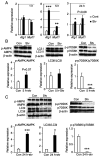Glucose, glutamine, lactic acid and α‑ketoglutarate restore metabolic disturbances and atrophic changes in energy‑deprived muscle cells
- PMID: 40376969
- PMCID: PMC12105454
- DOI: 10.3892/mmr.2025.13562
Glucose, glutamine, lactic acid and α‑ketoglutarate restore metabolic disturbances and atrophic changes in energy‑deprived muscle cells
Abstract
Skeletal muscle atrophy is often triggered by catabolic conditions such as fasting, malnutrition and chronic diseases; however, the efficacy of nutritional supplementation in maintaining muscle mass and preventing muscle atrophy remains controversial. The present study aimed to compare the inhibitory effects of various nutritional substrates on starvation‑induced catabolic changes and muscle cell atrophy. C2C12 muscle cells were starved for up to 24 h in medium lacking serum and main nutrients (glucose, glutamine and pyruvate). To assess the effects of exogenous substrates, the cells were incubated in starvation medium and individually supplemented with each of the following nutrients: Glucose, amino acids, fatty acids, lactate or ketone bodies. The expression of each gene and protein was analyzed by reverse transcription‑quantitative PCR and western blotting, respectively. Mitochondrial activity was determined by MTT assay and cell morphology was observed by immunofluorescence staining. The results revealed that starvation for >3 h suppressed mitochondrial activity, and after 5 h of starvation, the expression levels of several metabolic genes were increased; however, the levels of most, with the exception of Scot and Cpt‑1b, were suppressed after 24 h. Protein degradation and a decrease in protein synthesis were observed after 5 h of starvation, followed by autophagy with morphological atrophy at 24 h. Supplementation with specific substrates, with the exception of leucine, such as glucose, glutamine, lactic acid or α‑ketoglutarate, attenuated the suppression of mitochondrial activity, and altered gene expression, protein degradation and myotube atrophy in starved myotubes. Furthermore, the decrease in intracellular ATP production after 24 h of starvation was reversed by restoring glycolysis in glucose‑treated cells, and via an increase in mitochondrial respiration in cells treated with glutamine, lactic acid or α‑ketoglutarate. In conclusion, increasing the availability of glucose, glutamine, lactic acid or α‑ketoglutarate may be beneficial for countering muscle atrophy associated with inadequate nutrient intake.
Keywords: atrophy; metabolism; muscle cells; nutrient substrates; starvation.
Conflict of interest statement
The authors declare that they have no competing interests.
Figures







Similar articles
-
Short-term starvation is a strategy to unravel the cellular capacity of oxidizing specific exogenous/endogenous substrates in mitochondria.J Biol Chem. 2017 Aug 25;292(34):14176-14187. doi: 10.1074/jbc.M117.786582. Epub 2017 Jun 29. J Biol Chem. 2017. PMID: 28663370 Free PMC article.
-
Versatility of microglial bioenergetic machinery under starving conditions.Biochim Biophys Acta Bioenerg. 2018 Mar;1859(3):201-214. doi: 10.1016/j.bbabio.2017.12.002. Epub 2017 Dec 19. Biochim Biophys Acta Bioenerg. 2018. PMID: 29273412
-
Panax ginseng Total Protein Facilitates Recovery from Dexamethasone-Induced Muscle Atrophy through the Activation of Glucose Consumption in C2C12 Myotubes.Biomed Res Int. 2019 Aug 6;2019:3719643. doi: 10.1155/2019/3719643. eCollection 2019. Biomed Res Int. 2019. PMID: 31467885 Free PMC article.
-
Energy substrates and amino acids provided during in vitro maturation of bovine oocytes alter acquisition of developmental competence.Zygote. 1998 Nov;6(4):285-94. doi: 10.1017/s0967199498000239. Zygote. 1998. PMID: 9921638
-
Spatheliachromen mitigates methylglyoxal-induced myotube atrophy by activating Nrf2, inhibiting ubiquitin-mediated protein degradation, and restoring mitochondrial function.Eur J Pharmacol. 2024 Dec 5;984:177070. doi: 10.1016/j.ejphar.2024.177070. Epub 2024 Oct 21. Eur J Pharmacol. 2024. PMID: 39442745
References
MeSH terms
Substances
LinkOut - more resources
Full Text Sources
Research Materials

